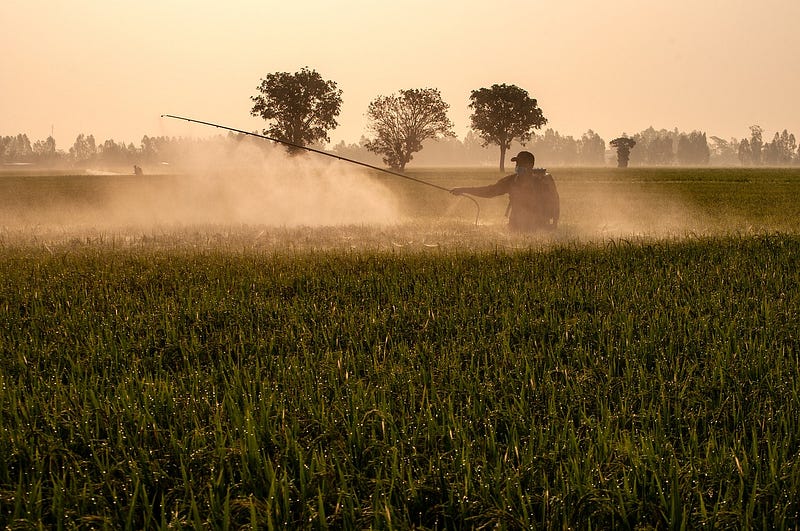The Hidden Battle: Understanding the War on Agricultural Pests
Written on

One of the most significant challenges faced by farmers globally is the relentless battle against invasive weeds and destructive insects that threaten their crops. For many, the development of effective pesticides is seen as a miraculous solution, akin to wearing polarized sunglasses that obscure unpleasant sights. Humanity's reliance on visual perception shapes our reality, yet unseen dangers often lurk beneath the surface.
A Troubling Legacy
What characteristics define a pesticide as "visibly" effective? It is typically one that is highly toxic and lethal to various pests across generations. The ideal pesticide operates like a magic shotgun, leaving no chance for pests to survive.
Consider the persistent issue of herbivorous insects. While many methods exist to eliminate these pests, not all yield immediate visible results. Some chemists discovered that targeting the nervous system of insects can lead to instant incapacitation, giving rise to the infamous organophosphate pesticides.
These compounds inhibit the essential neuromuscular enzyme acetylcholinesterase, resulting in overstimulation of nerve cells, ultimately leading to exhaustion. They can penetrate all surfaces of an insect's body, leaving little chance of escape. The horror doesn't end there; farmers were unaware that these "miraculous" chemicals evolved from some of the most lethal nerve agents used in warfare. Since mammals, including humans, use a similar enzyme in their nervous systems, organophosphates pose significant risks to human health as well. For example, VX, a highly toxic agent used in various conflicts, bears a structural resemblance to the pesticide Parathion.

Even at low doses, repeated exposure to organophosphates can lead to cognitive impairments like memory issues and attention deficits, along with physical symptoms such as blurred vision and insomnia. High doses can cause convulsions, paralysis, and even death.
On a positive note, organophosphates are generally biodegradable, as their components are common in nature. However, the rise of less biodegradable alternatives like organochlorides has resulted in more severe ecological consequences. These chemicals, which can accumulate in the environment, have been linked to health issues in humans and non-target organisms, despite bans in many developed countries.
The Illusion of Control
The distinction between "visually" effective and "actually" effective pest control is often lost on many, including farmers. When pests become less visible, farmers may believe they have succeeded, leading to excessive pesticide application. This over-reliance results in the unintended demise of beneficial organisms, exacerbating pest problems in subsequent growth cycles.
Weeds, arguably more damaging than insect pests, present another significant challenge. Controlling weeds often requires broad-spectrum herbicides, necessitating precise timing and application to avoid harming crops. Even selective herbicides can lead to the emergence of more resistant weed species.
A groundbreaking solution has emerged with gene-editing technology, allowing scientists to create crops resistant to widely used herbicides like glyphosate. While this innovation simplifies weed management for farmers, it raises concerns about the broader ecological impact, as beneficial plant species and nutrient cycling are disrupted.
Moreover, glyphosate and its byproducts have been detected in various environmental samples, indicating potential health risks, including liver and kidney damage and even cancer.
As we analyze these issues, it becomes evident that short-term visual results often conflict with long-term ecological health. The balance of power in this scenario seems to favor chemical solutions over sustainable practices.
A Complex Future
While pesticides play a crucial role in pest management, their implications for the environment cannot be overlooked. Over the last four decades, global food production has doubled, yet pesticide use has skyrocketed by more than 15 times. This indicates a troubling reliance on chemicals rather than addressing underlying issues in agricultural practices.
Experts question the necessity of pesticides for global food security, highlighting that crop damage from pests has increased despite rising pesticide use. This suggests a decline in agroecosystem resilience, leading to greater vulnerability to pest pressures.
The challenge lies in balancing immediate needs with long-term sustainability. The question remains: do we need to pursue a perfectly manicured landscape, or can we embrace more natural methods of pest management that may require more effort but ultimately contribute to a healthier ecosystem?
In conclusion, as we reflect on our agricultural practices, it's essential to consider whether the pursuit of perfection is worth the ecological cost. Perhaps the answer lies in embracing organic and labor-intensive methods that foster biodiversity and ecological balance.
Thank you for reading! I hope you found this article informative. If you enjoyed my writing, consider subscribing for more insights!
All my stories are freely accessible here: